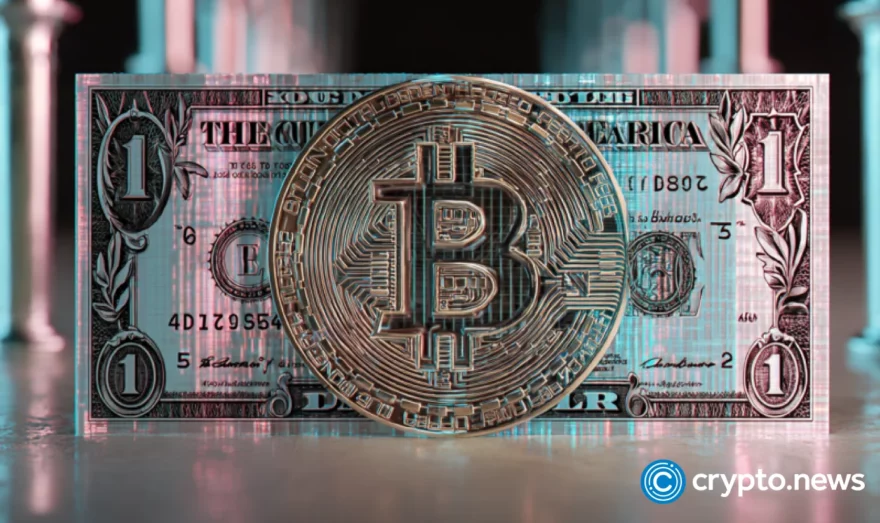Research analyst at Fineqia discusses the impact of spot ETFs on Bitcoin’s market dynamics

Crypto.news recently sat down with Matteo Greco from Fineqia International to discuss the current state of the Bitcoin ETF market and what we can expect looking ahead.
Bitcoin has emerged as one of the top-performing assets of the past decade.
It has transcended beyond its status as a lesser-known peer-to-peer payment system, catalyzing the creation of an entirely new asset class that now boasts a market capitalization exceeding $1 trillion.
With the approval of 11 spot Bitcoin ETFs in January 2024, traditional investors now have an easier route to gain exposure to the flagship cryptocurrency.
These investment vehicles are reshaping the crypto sector, having pulled in billions in market capital. Besides legitimizing Bitcoin, these have also drawn substantial interest from institutional players.
Another factor that might impact the Bitcoin ETF sector is the potential approval of spot ethereum ETFs. Analysts expect these to capture 20% of the investment flows currently heading towards spot Bitcoin ETFs, further adding to the intrigue.
With these developments in place, the market remains a dynamic and unpredictable arena. The future of Bitcoin ETFs, while promising, is being shaped by a myriad of factors, including regulatory developments and macroeconomic trends.
How might these influence the market dynamics of these investment vehicles? How could these impact the price of Bitcoin?
According to Greco, the inflows into Bitcoin ETFs are significant but not the sole factor influencing Bitcoin’s price.
Why does the substantial influx of capital into Bitcoin ETFs not correspond with an equivalent rise in Bitcoin’s market price?
There are several factors that can drive the price up and down, including supply and demand, liquidity, and leverage. It’s not as simple as a single-factor correlation for price action. However, it is incorrect to say that the inflow did not sustain positive price action. When the BTC ETFs were approved on January 10th, the price of BTC was about $46,000. Currently, BTC has been ranging between $65,000 and $70,000 for weeks, indicating a 40% – 50% price increase post-approval. At the time of the approval, BTC’s total market cap was about $900 billion, and now, with BTC at $67,000, it is about $1.3 trillion. This represents a $400 billion increase in total market cap, while BTC ETFs saw around $16 billion in net inflow. This means BTC’s market cap growth has been 25 times the amount of net inflow into the BTC Spot ETFs. This demonstrates that the impact of the approval and trading of these products has been substantial, extending beyond direct inflow into these financial products. It has helped sustain demand for the asset due to positive sentiment and mid-term expectations about Bitcoin and the digital assets space in general.
Could the potential approval of an Ethereum ETF significantly alter the investment landscape for Bitcoin ETFs?
Bitcoin (BTC) and Ethereum (ETH) are fundamentally different assets with distinct intrinsic characteristics. Bitcoin uses a Proof-of-Work consensus mechanism, which relies on miners, while Ethereum, like most digital assets, employs Proof-of-Stake, which does not require computational power to confirm transactions. This mechanism allows ETH and many other digital assets to offer staking rewards to investors, similar to dividends in traditional finance. BTC, however, does not have built-in staking rewards and, as a result, has different characteristics and cannot be classified as a security. Given the differing characteristics and use cases of these two major digital assets, I do not anticipate outflows from BTC ETFs moving into ETH ETFs. Instead, I expect net inflows for ETH ETFs as they represent a distinct asset that new investors, or those who have already invested in BTC ETFs, might also want to gain exposure to.
What impact might the introduction of an Ethereum ETF have on Bitcoin’s status as the premiere cryptocurrency?
BTC was the most prominent cryptocurrency before the ETFs were approved and will remain so after both BTC and ETH ETFs are approved. If BTC ever loses its dominance, it will take considerable time for ETH to surpass BTC in market cap. It will be interesting to observe traditional finance’s appetite for ETH as an asset. For comparison, BTC attracted about $16 billion in net inflows during Q1 and Q2, assuming quite neutral flows for the remaining three weeks of Q2 for a matter of simplicity. ETH’s market cap is about one-third of BTC’s, so proportionally, it should attract around $5 billion in the six months post-launch to match BTC’s level. Higher inflows would indicate more enthusiasm for ETH, and lower inflows would suggest the opposite. While it’s challenging to make direct comparisons due to differing market sentiments at the time of launch, this serves as a useful index for mid-term analysis.
Are traditional asset ETFs, such as those for gold, influencing the market dynamics of Bitcoin?
I would look at it from the opposite perspective. Traditional asset ETFs have been trading for a long time, and the introduction of digital asset ETFs into the market represents increased competition. For instance, the impact of BTC ETFs has been significantly stronger compared to the introduction of the first gold ETF in 2004. This indicates that investors have a definite appetite for digital assets, meaning that a portion of the allocation previously reserved exclusively for traditional financial assets is now being directed towards digital asset ETFs.
Regarding the influence of the BTC Spot ETFs in the market, these products undoubtedly bolster the global recognition of BTC. With some of the most significant traditional finance businesses issuing and/or holding BTC, this leads to increased liquidity, enhanced safety, and reduced spreads and commissions for investors and traders.
With the launch of ETFs has Bitcoin generated sufficient institutional and retail interest to sustain its proposed role as an inflation hedge?
I would not limit BTC to being classified solely as an inflation hedge. While BTC can serve as an inflation hedge over long time frames, it is not a safe hedge in the short term due to its high volatility. BTC has attracted strong institutional and retail interest for a variety of use cases, which highlights its versatility. Being entirely decentralized, without a CEO or board, investors can purchase and trade BTC based on their preferred use case. Some people buy and hold BTC as a long-term investment or inflation hedge. In countries with hyperinflation, people might use BTC as a short-term inflation hedge. Others see it as a speculative investment, while some appreciate its decentralized nature and the idea of a currency not issued by central governments. It’s incorrect to pigeonhole BTC into a single category. Bitcoin is an asset that can be used for various purposes depending on individual circumstances and preferences, and its overall adoption is increasing worldwide.
Would you classify Bitcoin as a traditional investment hedge like gold?
At the current stage, I would classify BTC more as an investment, similar to stocks, due to its high volatility rather than an inflation hedge like gold or bonds during periods of high interest rates. In my view, an inflation hedge should primarily offer high stability and serve as an alternative to fiat money—something stable and liquid that can be easily used to pay for services and quickly converted to cash in an emergency. BTC falls short in this regard because its value can vary dramatically depending on market conditions, which means converting BTC to fiat could result in significant losses if done at an unfavorable time.
What does this mean for Bitcoin?
While BTC can serve as a long-term inflation hedge and a means to increase purchasing power, it cannot be defined as an inflation hedge by default. For instance, during the past bear market, BTC experienced its biggest drawdowns coinciding with peaks in inflation and interest rate hikes. Conversely, BTC began performing well again when central banks stopped raising interest rates as inflation decreased. If BTC were a short-term inflation hedge, it would have behaved oppositely, rising during high inflation and macroeconomic uncertainty and slowing down when inflation decreased and interest rates stabilized. This pattern indicates that BTC is currently traded more as a risk-on asset, similar to stocks, rather than a short-term inflation hedge. As mentioned earlier, BTC’s decentralized nature means investors can define its function in the market. Presently, the majority of investors perceive BTC as a risk-on asset and trade it accordingly.














